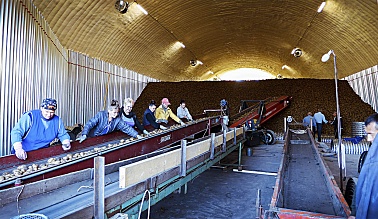Bulk storage
07.05.2018 | Bulk storage
Bulk storage is one of the most common ways of storing vegetables in Russia. It has become incredibly popular due to the sheer simplicity of this type of storage. Moreover, potatoes, which are the most high-demand product, are stored this way.
Main advantages
- allows for the storage of a high volume of vegetables
- efficient ventilation and produce drying
- the same temperature is maintained throughout the whole storage
- small amount of technological equipment
- high speed of erection and affordability
Bulk storage is perfect for potatoes, onions and beets.
There are some rules for bulk storage. First of all, the storage should be isolated from the outside environment and protected from the cold. Inside the building, there should be units for storing produce. Depending on the type of vegetables and their sorts and purpose, the number of individual rooms could be sizeable. A specific microclimate is maintained in each room.
The fundamental arrangement for maintaining the right microclimate in a vegetable storage entails the presence of an air-preparation chamber. The chamber usually consists of a load-bearing wall and a wall of the vegetable storage building. Fresh air passes through the intake valves located on both sides of the building and continues into the air-preparation chamber, where it gets the required temperature and humidity. The temperature and humidity of the incoming air can be regulated with the use of the recycle valves, humidifiers, heaters and coolers, which are located in the room. The prepared air flows into perforated pipes with the help of high-pressure fans. Fans can be installed either directly in pipes or on the hollow floor in an air-preparation chamber. The air flows into the storage through the air ducts.
Perforated pipes can be made from galvanized steel, which prolongs the service life of these items. A cost-effective way is to use wooden pipes. Nowadays, the efficiency of storage usage is critically important. A slotted floor is used for increasing the amount of vegetables in storages. The slotted floor is located on the underfloor ducts. Not only does this make it possible to use the room space sparingly, but it also makes the functioning of storage equipment and air distribution convenient. It ventilates, humidifies and heats the vegetables. Waste air is removed though the open intake and recycle valves and mixes with the fresh incoming air. In order to prevent the formation of condensation in a vegetable storage, special fans are used (some of which are equipped with heating elements).




